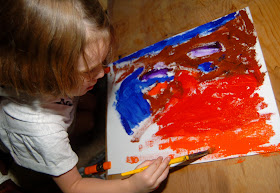We are so very proud that the Art Pavilion in Zagreb chose Nektarina Non Profit as its delivering partner for the "Learn through creative expression" workshops.
Workshops embrace the principle that arts education can positively and profoundly impact a person’s life, especially when received early in life. By providing avenues for creative exploration, these workshops will expose children and youth to the tangible benefits of arts education through the joys of creating and learning.
Numerous studies indicate that people who receive arts education early in life reap many tangible, long-term, life-changing benefits. From enhanced critical thinking, improved self-esteem and ability to collaborate, to improved scores in math and science, children gain skills that can help them well into adulthood.
Research shows that vibrant and prosperous communities begin with children that are healthy in every domain: language/cognitive/communication abilities, social/emotional skills and physical well-being.
Children who develop arts literacy (knowledge, skills and ability), will have the opportunity to:
- Learn to appreciate the arts as participants and spectators
- Learn technical skills
- Gain a wider view of themselves and their opportunities in the world
- Develop self-confidence and self-worth
- Explore and develop creativity and innovation
- Develop an ability to make decisions independently
- Learn how to work with others
- Develop discipline
- Learn to set and achieve goals
- Improve their odds of success in all areas of their lives
Through activities that are challenging, meaningful, and based on strong arts education principles, workshops we have created together with the Art Pavilion in Zagreb can expect to have a positive impact on the lives of the children it serves.
From increased self-confidence to ability to work with others, the benefits of arts education resonate beyond the development of well-rounded children, and play an integral role in building strong, healthy and dynamic communities.
The Art Pavilion is the oldest exhibition hall on the Slavic south and the only
building that has been purpously built for big, representative
exhibitions to be held in it. Together with the number of remarkable names from Croatian art history,
exceptional names from other countries have appeared here.
Croatian culture
has never been closed or exclusive one, on the contrary, it has been
naturally opened to the world, and the Art Pavilion in Zagreb was the
place where great names from other countries were most seemly
entertained.
The need for an exhibition hall, where big exhibitions of
artists and cultural importance can be held, was felt in Zagreb in the
last decade of the 19th century when art life started to develop more
intensely. The original idea and initiative for the construction of the
Art Pavilion in Zagreb was given in 1895 by a painter Vlaho Bukovac, the
most remarkable person in Zagreb’s artistic and cultural life on the
transition of the centuries. The possibility of the realization of construction
of the Art Pavilion in Zagreb appeared during the preparations for the
Millenium exhibitions in Budapest, whose gala opening was planned for
2nd May 1896. Hungary celebrated “the festivity of millenium” - a
millenium of its nationally constructive life, so Croatia and Slavonia,
which were politically and juridically connected with Hungary, had to
contribute actively to the exhibition.
The invitation for the building of the Art Pavilion in Zagreb was officially published, and Viennese architects Hellmer and Fellmer (famous designers of theatres) were charged with commission. The construction work was performed by two building constructors from Zagreb - Honigsberg and M. Lenuci. After two years - 1897 and 1898 - the building of the Art Pavilion in Zagreb was finished, and the building itself was ceremoniously opened an 15th December 1898 with the representative exhibition called Croatian salon.
One of the most
beautiful Zagreb’s downtown ambients was deliberately planned and
horticulturally rounded off in a “green horse-shoe”, and the Art
Pavilion in Zagreb has most finely grown into its environment and became
a participant of the creative integrity. The Art Pavilion in Zagreb is
the place of the most concentrated insight into out own history, it is
the stage where chosen parts from artistic, cultural and political
present and past have been periodically set. In the period of two and a
half past decades, the Art Pavilion in Zagreb found its basic function
just in the presentation and valorization of characteristic courses and
unavoidable contributions of the national tradition.
Big exhibition projects with wide thematic variety demand a wide range
of co-operation, either with related institutions or the most competent
critics - art historians or associates of various profiles who try to
make every exhibition project into a creative event, interesting for the
media.
For every exhibitions that the Art Pavilion in Zagreb realize,
and especially for retrospective and problem exhibitions, a
comprehensive, representative catalogue is printed. For their scholary
and meticulous, solid elaboration, together with a critical approach to
certain subject-matter, some of the catalogues published by the Art
Pavilion in Zagreb have become compulsory text-books for art history
students on Zagreb University.
In the coming period, the institution
will keep pleading for continual and meticulous observation and
elaboration of the most prominent persons and events of the Croatian
art’s past and present - in its programmes of work. A number of
unexplored chapters of Croatian rather old heritage and more modern art
production is what is left, together with certain names that deserve
scientific elaboration and whose work is still unexplored and has not
yet been critically evaluated.
All this is possible, because this place
has its own specific role in Zagreb’s cultural environment, which is the
result of the Art Pavilion in Zagreb being the central place and
intersection of big fine art events in Croatian art, during its history
and existence.
Find this and more information by visiting http://www.umjetnicki-paviljon.hr/en/
Find this and more information by visiting http://www.umjetnicki-paviljon.hr/en/



